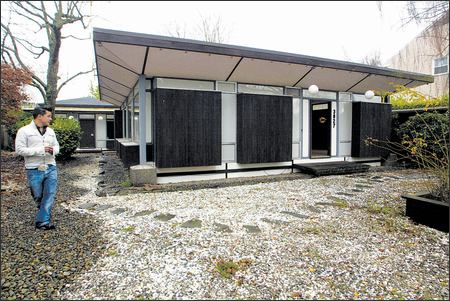Schwarz
View current page
...more recent posts
As with many contemporary thinkers, Eisenman rejects the redemptive notion of collective memory and its unexamined links to the sacred, which unite its celebrants in a reassuring cult of remembrance. Memorials, Eisenman has noted, are not about memory but about nostalgia. In this case, architecture becomes a hermeneutic, probing, questioning, withholding solace and thus closure. However challenged or troubled by the work, visitors are never overwhelmed nor reduced to anxious impotence. Nothing affects them without their active, willed participation. By avoiding an iconic design, Eisenman has ensured that the whole cannot be apprehended from any single vantage point. There is no center, no resting spot for the eye or the body, no therapeutic catharsis. The tight weave of the project never loosens its grip on visitors, or allows them to yield attention to apperception. They have to negotiate the narrow fissures between the somber stelae virtually in single file. Anamnesis becomes a personal rather than a collective endeavor, and the injunction to remember is left the responsibility of each individual spectator.

The Hurricane Katrina crisis began for Bruneau on Monday, August 29th, shortly after the storm had passed through. A young woman lay dead in the middle of the 1900 block of Jackson Avenue. Her skull was crushed, and a fallen street light, blown down by the ninety-five-mile-an-hour winds, lay beside her. Along Jackson Avenue, people were emerging from shotgun shacks into a world of smashed oak trees and downed power lines. Some of them knew the woman. She had gone out during the storm to buy drugs.
plastic fantastic

albini desk from retromodern
Television producers Bert Schneider and Bob Rafelson came up with the idea of casting a rock-and-roll band that could star in its own televison series on NBC. They ran an ad in Variety and selected four young men to serve as members of the band: Michael Nesmith, Peter Tork, Davy Jones, and Micky Dolenz. They produced a pilot and called the group the Monkees. It was Boyce and Hart who did the songs for the pilot in 1966, including the singing. When rock impressario Don Kirschner was brought in to handle the music for the show, he told Boyce and Hart they didn't have a proven track record as producers and they were off the project, except as songwriters. As the show's first air date loomed, one music producer after another was acquired and then rejected for the project, while Tommy Boyce kept telling Kirschner that he and Bobby could handle it. Kirschner finally gave them a chance, Boyce and Hart recorded vocals and backing tracks for the first album, and then the Monkees recorded lead vocals.

But there are plenty of buyers, with some seeking investments and others just needing a place to live after losing a home. Most people are buying "high and dry," to borrow the term on every broker's lips since Katrina, but even that seems a surprising vote of confidence in the long-term prospects of New Orleans and the surrounding parishes. In the West Bank area, which lies west of the Mississippi River, November sales were up 99 percent, in dollar terms, over November 2004, according to data provided by Latter & Blum. And in the high-priced Garden and Warehouse districts, the firm's November sales more than doubled.
stern strike fist
"anybody die yet?"

also available : dennis, jeanne, frances, ivan, charlie, floyd, gorges, rita, bonnie, fran, bertha, andrew...
Uncle Tom's Cabin will one day be open to the public.
The owner of an 18th-century Colonial in Bethesda, Md., listed a three-bedroom house and attached 205-year-old log cabin for sale for $995,000 in October. Josiah Henson, a slave who lived on the former tobacco plantation for 30 years, inspired the Uncle Tom character in Harriet Beecher Stowe's 1852 novel.
Located on a one-acre site surrounded by McMansions, the house was not protected as a local landmark, so Montgomery County officials sprung into action, raising money to match a $1 million offer. Owner Greg Mallet-Prevost, whose mother owned the house since the 1960s, accepted the county's offer on Dec. 23.
wfmu best of '05
find those dj's archives here
fluff desk: curbed 2005 awards
nyt architecture critic NICOLAI OUROUSSOFF was on charlie rose last night. I like this guy. among other things he called out daniel liebskind for not having the courage to walk off the job in protest.
sol moscot glasses for the masses
via zars

Former renter Stephen Busto put a posting in Craigslist and hosted two open houses to try to save a 1960s-era "flexible home" from demolition.
In a house with only one door inside, privacy has to be a shared concept. Especially when the door leads to the one bathroom in a 1,000-square-foot house shared by a family of four.
Close quarters by necessity is one thing, but this was by design. In the era of the 1962 World's Fair, the dream of a "flexible house" became a reality for commercial architect Robert Allan Adams.
Adams designed the Mount Baker house to efficiently accommodate and change with his young family. Post-toddler, a playpen set into a recessed area turned into a conversation pit in the living room. Beds folded up into movable walls. Interior partitions doubling as storage units did not reach the flat ceiling, creating Spartan but well-ventilated rooms. Features such as these made the 1963 house seem at once very retro and future-fantastic for the way the space flowed through multiuse areas.
Now the house and its nearly identical 350-square-foot guesthouse are in danger of vanishing from modern Seattle architectural history if they can't find a new home. The new owner of the 8,240-square-foot lot wants to build his own house -- but he'd like to see the current house preserved if it can be taken away at no expense to him.
gary wilson / new video
history of the schwinn stingray

"festivus for the rest of us!"
nowottny sighting barely nearly
You were one of the first modernists who talked about the preservation of older buildings. Now we're in a different era where we're discussing modern preservation. What are your thoughts on this campaign?
If there's anything that really excises me, it's the lack of knowledge, the lack of standards, being applied indiscriminately across the board to modern buildings. I get so upset about it. You know how I feel about 2 Columbus Circle? This was an example of how you had to balance good against bad, past against future, reuse against what would happen to the building. The preservationists proved not only incapable of discussing it, but went into paranoia mode. I think the whole movement seems to be doing that. Of course it was a complex issue but they should have been able to sort it out. And then to compare--you always get one crazy directing these things who has the quality of leadership--Ed Stone's poor little lollipop building to the loss of Penn Station! They were really doing this! Although I did write in specific terms about 2 Columbus Circle, I haven't gotten myself down out of the emotional response enough to write in general terms about modern preservation.
progrock timeline
this and the last three via zoller
visual laser keyboard
floating homes
